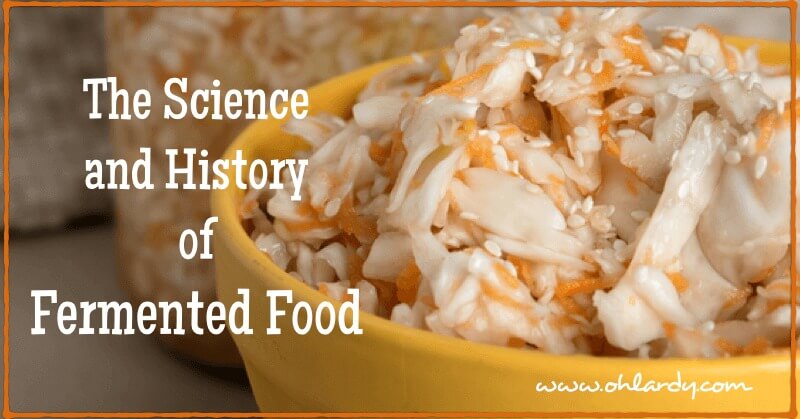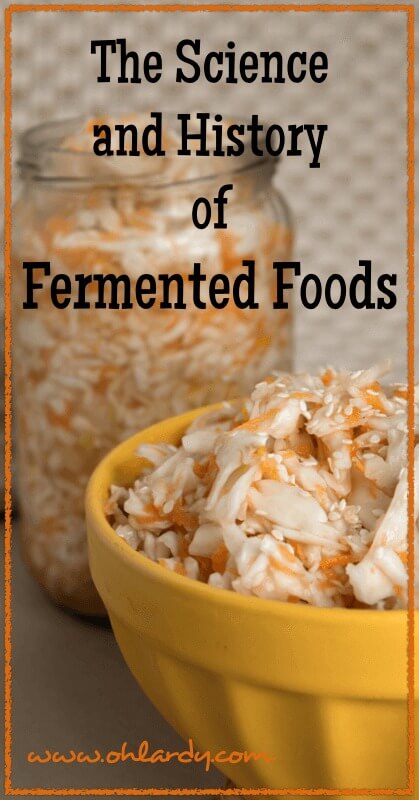The Science and History of Fermented Foods
Oh Lardy! is a participant in the Amazon Services LLC Associates Program, an affiliate advertising program designed to provide a means for us to earn fees by linking to Amazon.com and affiliated sites.

This is the second post in my series on the benefits to your gut health of adding fermented and cultured foods to your diet. As you know, I recently completed the Certified Healing Foods Specialist coursework through Immunitrition. I learned so much about culturing foods and I can't wait to share it all with you!
Do you ever wonder how ancient people preserved food, before the advent of refrigeration? One of the ways was through a process called lacto-fermentation.
Almost every traditional culture has fermented some sort of food to prevent spoilage (3). A honey wine, called mead, is thought to be one of the most ancient preserved foods, dating back thousands of years (4).
Weston A. Price, a dentist who travelled the world, studying primitive cultures found that almost all of the traditional cultures had some form of lacto-fermentation as part of their food culture.
Almost any food can be preserved via lacto-fermentation. Looking at a short list of commonly prepared fermented foods from around the world shows how common fermentation is.
Common Cultured Foods from Around the World:
- Sauerkraut (Europe) (1)
- Kimchi (Korea) (1)
- Cortido (South America) (1)
- Pickled Vegetables (Japan) (1)
- Traditionally pickled relishes, vegetables and watermelon rind (1)
- Sourdough (5)
- Kvass (Russia) (1)
- Kombucha (1)
- Ginger beer (1)
- Kaffir Beer (South Africa) (1)
- Pulque (Mexico) (1)
- condiments, such as mayo, ketchup and mustard(1)
Many fermented foods were made from dairy products. Nomadic herders found that raw, unpasteurized milk would quickly ferment causing the milk to separate (curds from the whey) and would become a “more stable and storable dairy product” (4).
Some examples of fermented dairy are:
- Yogurt (Bulgaria)
- Kefir (Russia, Turkey)
- Koumiss (Russia)
- Laban (Middle East)
- Dahi (India)
- Creme Fraiche (Europe)
- Sour Cream
- Sour or cultured butter (Europe)
- Cream Cheese or Yogurt Cheese
- Piima (Finland) (1)
What exactly is fermenting or culturing food? (The terms ‘cultured' and ‘fermented' can be used interchangeably). Fermentation is actually a sort of pre-digestion that takes place when naturally present bacteria, usually of the lactobaccillus or bifidus strains, (or sometimes yeasts) begin breaking down the sugars and starches in the food.
As these bacteria divide, the process forms lactic acid (and sometimes acetic acid or alcohol (5)) which halts the growth of the ‘bad' or putrefying bacteria (1). This acid is also responsible for the sour taste that comes along with fermented foods (2).
As long as the foods are kept under a brine or a liquid, and in cool storage (a root cellar, for example) the product will last for months and months, sometimes years. (I currently have sauerkraut that is over one year old in my refrigerator and it is still delicious!)
Fermentation has many benefits in addition to being a great preservation technique.
Benefits of Cultured Foods:
- Fermented foods are more digestible and have increased vitamin levels (1, 5).
- Fermentation can also create new nutrients, particularly B-vitamins (5).
- Fermentation helps keep our guts full of ‘good' bacteria (1, 2, 3, 5).
- The lactic acid encourages the growth of healthy microbiota in our intestinal tract (1).
- Fermented grains can neutralize the anti-nutrient phytic acid naturally present in grains (6).
- Fermented foods can help boost our immunity (2)
- Cultured foods can curb cravings for sweets and other overly processed foods (2).
Of course, traditional cultures did not know all the information we have now about cultured foods. However, they definitely knew that fermented food lasted longer, tasted better and made them feel better (5). We would be wise to remember techniques our ancestors have left for us.
Unfortunately, the typical American diet (SAD) does not consist of many (if any) fermented foods. Most people eat a diet full of overly processed, sugar and additive laden, non-nutritious foods that are destroying the bacteria in their intestinal tract.
Foods that were traditionally fermented or cultured, are now preserved in different ways (pickling with vinegar and canning for example) so the good bacteria is no longer present.
Adding fermented foods to your diet is easy and, if you make them yourself, very affordable. A serving of cultured food can contain 10s of trillions of probiotics! That is equal to an entire jar of an expensive over the counter probiotic capsules!
It is very easy to culture foods in your own kitchen. Don't be scared to try! Create a sourdough starter! Hopefully by the end of this series, you will feel confident to give it a go!
My next post will be about materials you need to culture your own foods as well as some recipes and tutorials for you to follow!
Does the topic of fermenting baffle you? We created a Fermenting eCourse just for you and when you sign up, we will send you a Quick Start Guide! Grab the eCourse and the guide here!
Pin It!
If you want more information about fermentation, ‘good' bacteria, and the health of your ‘gut', check out my other posts in this series:
What You Need to Culture Fruits and Vegetables at Home
10 Uses for Fermented Foods (and an easy recipe)
Lacto-fermented Pineapple Papaya Chutney, a delicious digestive aid
If you are new to Real Food, check out Getting Started with Real Food!
Sources:
1. Nourishing Traditions by Sally Fallon
2. Taking the Mystery Out of Culturing Your Own Superfoods
3. http://articles.mercola.com/sites/articles/archive/2012/06/27/probiotics-gut-health-impact.aspx
4. Wild Fermentation by Sandor Katz
5. http://www.marksdailyapple.com/the-definitive-guide-to-traditional-food-preparation-and-preservation/
6. http://www.holistickid.com/phytic-acid-the-bane-of-grains/
This post is featured on Kelly the Kitchen Kop's Real Food Wednesday.


Just curious – is it possible to eat *too much* fermented foods???
It is possible. Start slowly and build up. If you experience stomach discomfort, dial back the amount you are eating!
This was perfectly timed. My husband was just starting a serving of sauerkraut when I saw this on Pinterest. I did not know the bit about one serving having as many probiotics as a jar of capsules. I’m fascinated by fermented foods!
Yes! Fermented foods are very, very fascinating!!! Enjoy!
Is there any science behind this? Obviously the processed foods that everyone eats kills the good bacteria but I cannot find the science that backs up how the process foods destroys the food bacteria.
Well pasteurization absolutely destroys food bacteria, so yes, that would be the science that backs it up.